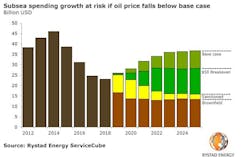Rystad Energy: High stakes in store for subsea markets if oil falls to $50/bbl
The subsea market in 2019 will experience year-on-year growth for the first time since 2014, but the positive outlook is vulnerable to any substantial decline in oil prices over the next few years.
“We expect the subsea market to thrive during the coming years, but market growth will be at risk if the oil price falls to $50/bbl,” says Henning Bjorvik, an analyst on Rystad Energy’s oil field service team.
Development this year is essentially locked in with brownfield opportunities and already sanctioned projects—but the oil price will dictate growth moving forward.
In a $60-70/bbl oil environment, the subsea market is poised to increase about 7%/year up to 2025. But a large portion of this activity is at risk if the price of Brent crude falls to $50/bbl. The consulting firm believes prices at that level would still be enough to support 5%/year growth in the subsea market through 2022, but after that the growth rate could fall to zero.
“Although we expect the subsea market to have one of the highest growth rates within oil field services, the segment is also more vulnerable to an oil price drop than the oil field services market in general. We see significant risks in terms of subsea spending as well as growth,” Bjorvik noted.
Segments with especially high exposure to greenfield activity, such as the subsea equipment and SURF (subsea umbilicals, risers, and flowlines) segments, are at risk of having growth slashed by almost 5%/year. This stands in stark contrast to the oil field services market, which exhibits around 3%/year growth at risk over the same timeframe.
This trend is echoed when looking at spending at risk from 2019 through 2025—close to 20% of spending in the subsea equipment and SURF segments is at risk, while about 10% of general oil field services market spending is at risk should the oil price fall from our base case estimate to $50/bbl.
Spending at risk is largely dominated by floater projects globally, but in Norway is manifested in subsea tie-back projects. No fewer than 16 projects with subsea expenditure between 2019 and 2025 are at risk on the Norwegian continental shelf, 14 of which are subsea tie-back projects.
“It is worth mentioning that operators have had a remarkable ability to cut costs during downturns, much helped by the oil field service industry,” Bjorvik said. “Should a lower price environment again become reality, we can be assured that the industry has a proven track record of survival and ingenuity.”
